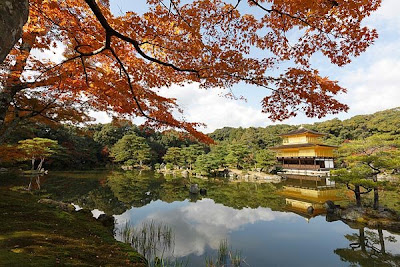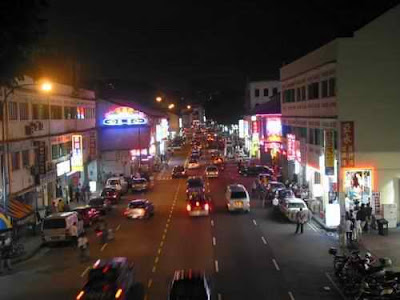Zen and the Art of Golden Temple Maintenance
 200,000 gold foils, 1 mad monk and a 67-year-old craftsman... of such things are Japan's Kinkaku-ji Golden Pavilion made. With over 600 years of history, this magnificent building is perhaps the second most recognized symbol of Japan, after Mount Fuji. Located in an idyllic garden setting in Japan's ancient former capital of Kyoto, the glimmering structure is set like a jewel on the shore of a tranquil reflecting pond.
200,000 gold foils, 1 mad monk and a 67-year-old craftsman... of such things are Japan's Kinkaku-ji Golden Pavilion made. With over 600 years of history, this magnificent building is perhaps the second most recognized symbol of Japan, after Mount Fuji. Located in an idyllic garden setting in Japan's ancient former capital of Kyoto, the glimmering structure is set like a jewel on the shore of a tranquil reflecting pond.Commonly known as the Kinkaku-ji, the so-called "Golden Temple" is actually an outbuilding of the Rokuon-ji temple. It is also known as the Golden Pavilion or in Japanese, "Kinkaku" where "Kin" means "gold". The original building was constructed in the year 1397 under the patronage of the Shogun Ashikaga Yoshimitsu and has been maintained until this day by the resident monks.




Over 1.5 million people visit Kinkaku-ji every year and the pavilion's structure and surrounding grounds have been branded as a UNESCO World Heritage Site. There is no "best time" to pay a visit - each season brings its own unique flavor. The vivid greens of Spring and Summer, the reds and ochres of Autumn and perhaps most especially Winter's light sprinkles of brilliant white snow all complement and enhance the luminous glow and harmonious lines of this truly exceptional structure.



Although Kinkaku-ji may appear to display an ethereal and timeless beauty, its history has not always been so serene. Tragedy struck in 1950 when a schizophrenic monk driven by voices that hated beauty, decided burn it to the ground. The story of the monk named Hayashi Yōken was told in novelist Yukio Mishima's notorious semi-fictional book "The Temple of the Golden Pavilion" and was first published in English in 1959. The monk was captured and imprisoned (where he was interviewed by Mishima) after bragging about his crime to a prostitute. His mother who was unable to bear the shame committed suicide by throwing herself in front of a train. Yōken was released from prison in 1955 due to his illness and died a year later. By that time the restoration of the Golden Temple into its original specifications was already in full swing.




Reconstruction of the pavilion took many years of painstaking labor. The trademark gold leaf coverings on the upper floors were not completed until 1987 and their application was fraught with difficulty as only a few craftsmen were trained in such a specialized field. It was not until 2003 that the roof of the restored pavilion (which features a stylized golden phoenix perched at the nave) was finished to appease the satisfaction of the temple's monks.







These days, maintenance of the Golden Temple's exquisite visage is entrusted to one single man: 67-year-old Takesato Yagyu. You can read about Yagyu's devoted dedication to the Kinkaku-ji in detail right here. According to Yagyu the pavilion's original gold decorations were not rigorously maintained and after more than 500 years, little gold leaf was left. In this respect it can be said that the modern restoration of this iconic symbol of Japan has returned the Kinkaku-ji's appearance of the 14th century rather than 1949 (the year before the arson attack). After viewing the Golden Pavilion in all its restored glory, lit up and glowing serenely on a warm and fragrant Kyoto evening, I don't think anyone can argue against that!
Article by Steve Levenstein from Inventor Spot. Steve writes about weird and wonderful Japanese innovations on a regular basis and you can catch up on current & previous examples at his blog. Submit your thoughts - click here!



 'CERN's
'CERN's 

 Now I've been
Now I've been  The idea is this. We probably all know the concept of "
The idea is this. We probably all know the concept of " So, how does the Hexamodel work? Let's take me as an example. I'm a
So, how does the Hexamodel work? Let's take me as an example. I'm a 




 If you ever walk down the infamous red-light district of Singapore, Geylang, it is easy to be led into believing that the seeming progress made by the nation has neglected this part of the island. It is a shuddering sight seeing women of all races, age and nationalities dressing down to the bare minimum and standing at the road sides, soliciting for any potential business and the men scrutinizing them as if they were a piece of good to be purchased. Hotels and run-down shop houses lined alongside the roads and the air was heavily laden with a thick sense of uneasiness and disgust.
If you ever walk down the infamous red-light district of Singapore, Geylang, it is easy to be led into believing that the seeming progress made by the nation has neglected this part of the island. It is a shuddering sight seeing women of all races, age and nationalities dressing down to the bare minimum and standing at the road sides, soliciting for any potential business and the men scrutinizing them as if they were a piece of good to be purchased. Hotels and run-down shop houses lined alongside the roads and the air was heavily laden with a thick sense of uneasiness and disgust. Once in a while, police cars would drive past the roads and the women would scurry to hide as soliciting in public is still a crime, though prostitution isn’t. Apparently heading for another night of physical wasted-ness, a lady was walking past a small erected Buddha stature when she suddenly slowed her pace, turned and prayed. Was she praying for better business that night, or was she praying for the day when she can finally bide farewell to this form of self-degradation?
Once in a while, police cars would drive past the roads and the women would scurry to hide as soliciting in public is still a crime, though prostitution isn’t. Apparently heading for another night of physical wasted-ness, a lady was walking past a small erected Buddha stature when she suddenly slowed her pace, turned and prayed. Was she praying for better business that night, or was she praying for the day when she can finally bide farewell to this form of self-degradation? The two questions highlight the problems that come with the social dilemma posed by prostitution. It is easy to assume that prostitution, because it has always been prevalent in history (in the form of “white” slavery or sex trafficking), is thus acceptable though it remains a taboo subject to debate generously on. Yet, more often than not, we neglect the underlying problems that are made more conspicuous by the rise of this sex industry.
The two questions highlight the problems that come with the social dilemma posed by prostitution. It is easy to assume that prostitution, because it has always been prevalent in history (in the form of “white” slavery or sex trafficking), is thus acceptable though it remains a taboo subject to debate generously on. Yet, more often than not, we neglect the underlying problems that are made more conspicuous by the rise of this sex industry. Poverty, war and social exclusion are just some of
Poverty, war and social exclusion are just some of Prostitution, the
Prostitution, the